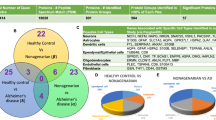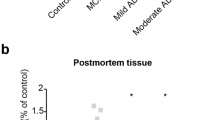Abstract
Choroid plexus homogenates from 27 cases with Alzheimer disease-related pathology (AD), stages I/0 (n = 5), III–IV/0-B (n = 15) and V–VI/B-C (n = 7) and 3 age-matched controls (no clinical symptoms, no neuropathological lesions) were processed for gel electrophoresis and western blotting for oxidation markers carboxymethyl-lysine (CML) and N-carboxyethyl-lysine (CEL). Increased CEL and CML expression was seen in AD cases stages IVB, and V–VI/B-C when compared to controls and cases with AD-related pathology classified as I/0 and III/0. Variable stress damage was seen in stage III/B. Although lower stages of AD did not show β-amyloid deposition in the choroid plexus, the amount of β-amyloid was very variable at stages V/VI as revealed by western blotting, suggesting that other factors in addition to local fibrillar β-amyloid were associated with oxidative damage in the choroid plexus. Two-dimensional gel electrophoresis and western blotting to CEL and CML in combination with mass spectrometry disclosed increased intensity of variable spots in AD cases leading to the identification of tyrosine 3/tryptophan 5-monooxygenase activation protein, zeta polypeptide, tropomyosin 3 isoform, and apolipoprotein A-II (ApoA-II) as targets of increased oxidative damage in AD. Oxidation of these proteins may result in impaired protein interactions, protein folding and protein kinase activity; abnormal function of endothelial and vascular smooth muscle cells; and impaired HDL-cholesterol metabolism in the choroid plexus in advanced stages of AD.




Similar content being viewed by others
References
Baynes JW, Thorpe SR (2000) Glycoxidation and lipoxidation in atherogenesis. Free Radic Biol Med 28:1708–1716
Berg D, Holzmann C, Riess O (2003) 14-3-3 proteins in the nervous system. Nat Rev Neurosci 4:752–762
Boyd-Kimball D, Castegna A, Sultana R, Poon HF, Petroze R, Lynn BC, Klein JB, Butterfield DA (2005) Proteomic identification of proteins oxidized by Abeta(1-42) in synaptosomes: implications for Alzheimer’s disease. Brain Res 1044:206–215
Boyd-Kimball D, Poon HF, Lynn BC, Cai J, Pierce WM Jr, Klein JB, Ferguson J, Link CD, Butterfield DA (2006) Proteomic identification of proteins specifically oxidized in Caenorhabditis elegans expressing human Abeta(1-42): implications for Alzheimer’s disease. Neurobiol Aging 27:1239–1249
Boyd-Kimball D, Sultana R, Poon HF, Lynn BC, Casamenti F, Pepeu G, Klein JB, Butterfield BA (2005) Proteomic identification of proteins specifically oxidized by intracerebral injection of amyloid beta-peptide (1-42) into rat brain: implications for Alzheimer’s disease. Neuroscience 132:313–324
Braak H, Braak E (1999) Temporal sequence of Alzheimer’s disease-related pathology. In: Peters A, Morrison JH (eds) Cerebral cortex, vol 14. Neurodegenerative and age-related changes in structure and function of cerebral cortex. Kluwer Academic/Plenum Press, New York, pp 475–512
Butterfield DA, Drake J, Pocernich C, Castegna A (2001) Evidence of oxidative damage in Alzheimer’s disease brain: central role for β-amyloid peptide. Trends Mol Med 7:548–554
Butterfield DA, Lauderback CM (2002) Lipid peroxidation and protein oxidation in Alzheimer’s disease brain: potential causes and consequences involving amyloid beta-peptide-associated free radical oxidative stress. Free Rad Biol Med 32:1050–1060
Butterfield DA, Perluigi M, Sultana R (2006) Oxidative stress in Alzheimer’s disease brain: new insights from redox proteomics. Eur J Pharmacol 545:39–50
Butterfield DA, Poon HF, St Clair D, Keller JN, Pierce WM, Klein JB, Markesbery WR (2006) Redox proteomics identification of oxidatively modified hippocampal proteins in mild cognitive impairment: insights into the development of Alzheimer’s disease. Neurobiol Dis 22:223–232
Canton M, Neverova I, Menabo R, Van Eyk J, Di Lisa F (2004) Evidence of myofibrillar protein oxidation induced by postischemic reperfusion in isolated rat hearts. Am J Physiol Heart Circ Physiol 286:H870–H877
Canton M, Skyschally A, Menabo R, Boengler K, Gres P, Schulz R, Haude M, Erbel R, Di Lisa F, Heusch G (2006) Oxidative modification of tropomyosin and myocardial dysfunction following coronary microembolization. Eur Heart J 27:875–881
Dougherty MK, Morrison DK (2004) Unlocking the code of 14-3-3. J Cell Sci 117:1875–1884
Drake J, Link CD, Butterfied DA (2003) Oxidative stress precedes fibrillar deposition of Alzheimer’s disease amyloid beta-peptide 1-42 in a transgenic Caenorhabditis elegans model. Neurobiol Aging 24:415–420
Duyckaerts C, Dickson DW (2003) Neuropathology of Alzheimer’s disease. In: Dickson D (ed) Neurodegeneration: the molecular pathology of dementia and movement disorders. ISN Neuropath Press, Basel, pp 47–68
Dzieglielewska KM, Ek J, Habgood MD, Saunders NR (2001) Development of the choroid plexus. Microsc Res Technol 52:5–20
Ferrer I, Martinez A, Boluda S, Parchi P, Barrachina M (2008) Brain banks: benefits, limitations and cautions concerning the use of post-mortem brain tissue for molecular studies. Cell Tissue Bank 9:181–194
Houle F, Huot J (2006) Dysregulation of the endothelial cellular response to oxidative stress in cancer. Mol Carcinog 45:362–367
Houle F, Poirier A, Dumaresq J, Huot J (2007) DAP kinase mediates the phosphorylation of tropomyosin-1 downstream of the ERK pathway, which regulates the formation of stress fibers in response to oxidative stress. J Cell Sci 120:3666–3677
Lowe J, Mirra SS, Hyman B, Dickson DW (2008) Ageing and dementia. In: Love S, Louis DN, Ellison DW (eds) Greenfield’s leuropathology. Hodder Arnold, London, pp 1031–1152
Martín-Campos JM, Escola-Gil JC, Ribas V, Blanco-Vaca F (2004) Apolipoprotein A-II, genetic variation on chromosome 1q21-q24, and disease susceptibility. Curr Opin Lipidol 15:247–253
Moran CM, Garriock RJ, Miller MK, Heimark RL, Gregorio CC, Krieg PA (2008) Expression of the fast twitch troponin complex, fTnT, fTnI and fTnC, in vascular smooth muscle. Cell Motil Cytoskeleton 65:652–661
Nicholson-Flynn K, Hitchcock-DeGregori SE, Levitt P (1996) Restricted expression of the actin-regulatory protein, tropomyosin, defines distinct boundaries, evaginating neuroepithelium, and choroids plexus forerunners during early CNS development. J Neurosci 16:6853–6863
Pamplona R, Dalfó E, Ayala V, Bellmunt MJ, Prat J, Ferrer I, Portero-Otín M (2005) Proteins in human brain cortex are modified by oxidation, glycoxidation, and lipoxidation. Effects of Alzheimer disease and identification of lipoxidation targets. J Biol Chem 280:21522–21530
Pamplona R, Ilieva E, Ayala V, Bellmunt MJ, Cacabelos D, Dalfo E, Ferrer I, Portero-Otin M (2008) Maillard reaction versus other nonenzymatic modifications in neurodegenerative processes. Ann N Y Acad Sci 1126:315–319
Reed T, Perluigi M, Sultana R, Pierce WM, Klein JB, Turner DM, Coccia R, Markesbery WR, Butterfield DA (2008) Proteomic identification of 4-hydroxy-2-nonenal-modified brain proteins in amnestic mild cognitive impairment: insight into the role of lipid peroxidation in the progression and pathogenesis of Alzheimer’s disease. Neurobiol Dis 30:107–120
Santpere G, Puig B, Ferrer I (2007) Oxidative damage of 14-3-3 zeta and gamma isoforms in Alzheimer’s disease and cerebral amyloid angiopathy. Neuroscience 146:1640–1651
Scanu AM, Edelkstein C (2008) HDL: bridging past and present with a look at the future. FASEB J 22:4044–4054
Shin SJ, Lee SE, Boo JH, Kim M, Yoon YD, Kim SI, Mook-Jung I (2004) Profiling proteins related to amyloid deposited brain of Tg2576 mice. Proteomics 4:3359–3368
Sultana R, Boyd-Kimball D, Poon HF, Cai J, Pierce WM, Klein JB, Merchant M, Markesbery WR, Butterfield DA (2006) Redox proteomics identification of oxidized proteins in Alzheimer’s disease hippocampus and cerebellum: an approach to understand pathological and biochemical alterations in AD. Neurobiol Aging 27:1564–1576
Sultana R, Newman SF, Abdul HM, Cai J, Pierce WM, Klein JB, Merchant M, Butterfield DA (2006) Protective effect of D609 against amyloid-beta 1-42 induced oxidative modification of neuronal proteins: redox proteomics study. J Neurosci Res 84:409–417
Sultana R, Perluigi M, Buttefield DA (2009) Oxidatively modified proteins in Alzheimer’s disease (AD), mild cognitive impairment and animal models of AD: role of Abeta in pathogenesis. Acta Neuropathol 118:131–150
Tailleux A, Duriez P, Fruchart JC, Clavey V (2002) Apolipoprotein A-II, HDL metabolism and atherosclerosis. Atherosclerosis 164:1–13
Takahashi Y (2003) The 14-3-3 proteins: gene, gene expression, and function. Neurochem Res 28:1265–1273
Terni B, Boada J, Portero-Otín M, Pamplona R, Ferrer I (2009) Mitochondrial ATP-synthase in the entorhinal cortex is a target of oxidative stress at stages I/II of Alzheimer’s disease pathology. Brain Pathol (in press), PMID 19298596
Varadarajan S, Yatin S, Aksenova M, Butterfield DA (2000) Review: Alzheimer’s amyloid beta-peptide-associated free radical oxidative stress and neurotoxicity. J Struct Biol 130:184–208
Vargas T, Ugalde C, Spuch C, Antequera D, Morán MJ, Martín MA, Ferrer I, Bermejo F, Carro E (2008) Abeta accumulation in choroid plexus is associated with mitochondrial-induced apoptosis. Neurobiol Aging (in press), PMID 18838197
Acknowledgments
This work was funded by grant PI08/0582 from the Spanish Ministry of Health, Carlos III Institute of Health. We thank Maria Antonia Odena and Eliandre Oliveira of the Proteomics Platform, Barcelona Science Park, for mass spectrometry study; and T. Yohannan for editorial help.
Author information
Authors and Affiliations
Corresponding author
Rights and permissions
About this article
Cite this article
Perez-Gracia, E., Blanco, R., Carmona, M. et al. Oxidative stress damage and oxidative stress responses in the choroid plexus in Alzheimer’s disease. Acta Neuropathol 118, 497–504 (2009). https://doi.org/10.1007/s00401-009-0574-4
Received:
Revised:
Accepted:
Published:
Issue Date:
DOI: https://doi.org/10.1007/s00401-009-0574-4




